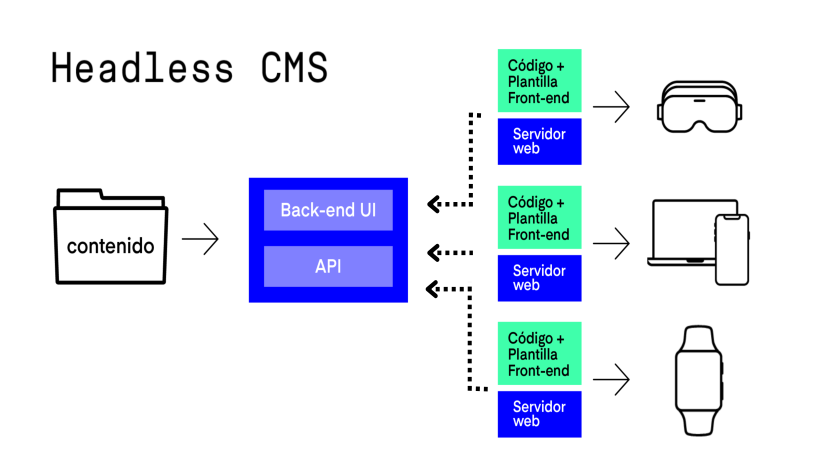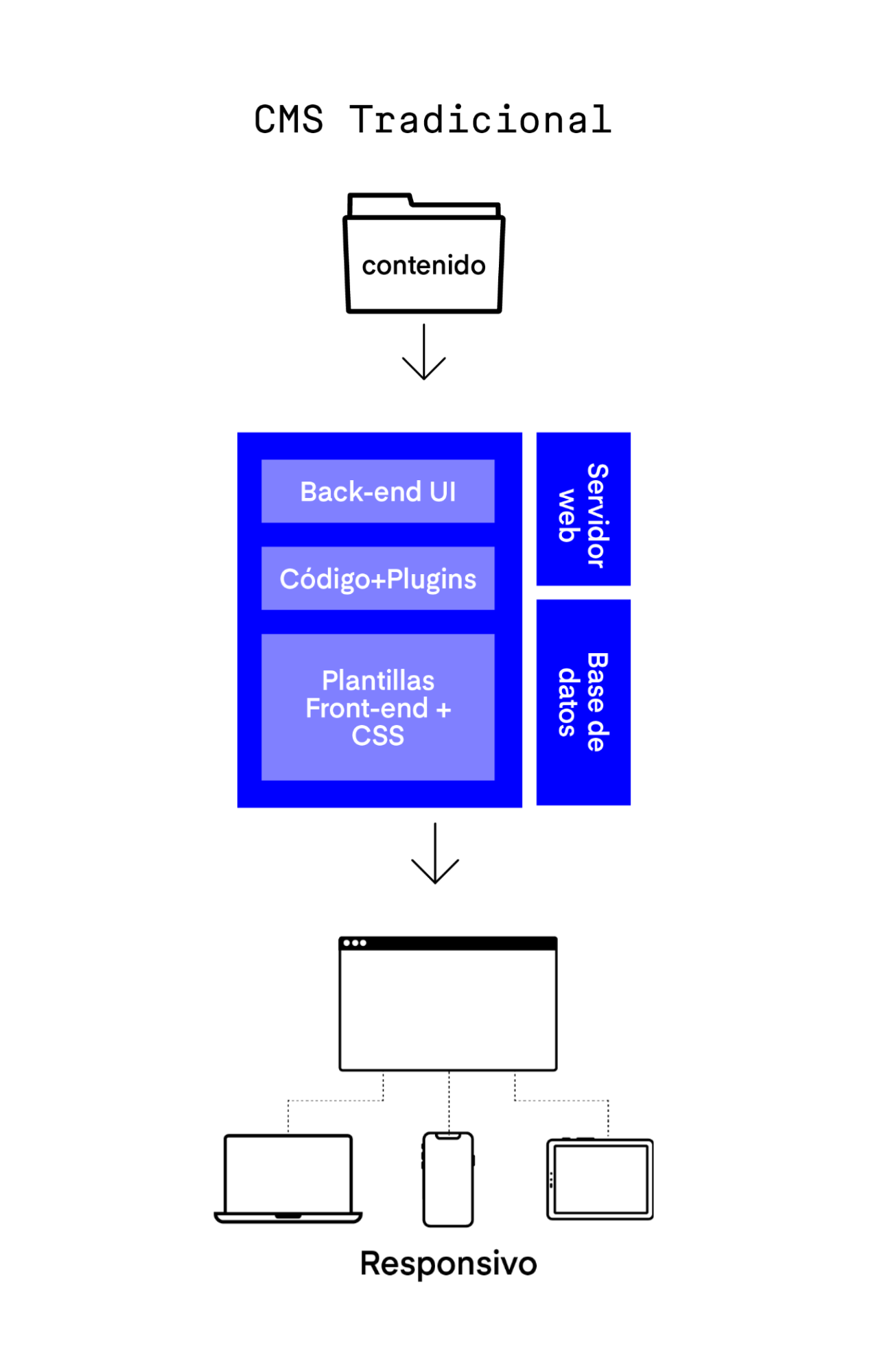What is Headless CMS and what are its advantages?

A Headless CMS is a content management system through which you can separate the frontend from the backend. Under this architecture, a CMS serves as a content repository, and this content can be called by an API to be deployed on multiple platforms.
For a long time, CMSs have been an essential tool on the internet to create and distribute content. They are a tool that facilitates the development of websites and allows marketing teams to create new content such as pages and articles quickly and easily.
In short, they have been functional tools in web development.
However, the architecture of the traditional monolithic CMSs is becoming obsolete for the speed at which the market moves and the needs of today's digital consumer.
They do not allow companies to develop products at a faster pace, adopt new and better technologies, display content on multiple channels, and personalize the user experience and interface more flexibly. Headless CMS is a software architecture that comes to solve these problems.
But before understanding what Headless CMS is, we must first clarify what a CMS is and how the architecture of the traditional CMS is composed.
What is a CMS?
CMS stands for Content Management System. A CMS is a tool that allows marketing teams to create, edit, and publish content directly on a website, mobile application, smart TV, or any other digital device.
These types of platforms are very common in web development because they allow someone without technical programming knowledge to generate articles, create pages, or upload images to a website.
What is a Traditional CMS?
In a traditional CMS, the user interface (frontend) and the part that stores and manages the content (backend) are unified. Basically, it is a single piece that stores the content and displays it on a digital channel or device.

Traditional CMSs are built under obsolete monolithic architectures. They live inside the client's servers, updates are manual, they have multiple complications to be integrated with new technologies, they are based on languages and libraries that are becoming less used, they are not designed to deliver content to multiple channels, among other problems.
As you can see, a traditional monolithic CMS poses several challenges for the technology team. Headless has come to solve many of these problemas.
What is a Headless CMS?
A Headless CMS separates the frontend from the backend. Under this architecture, a CMS serves as a content repository, and this content can be called by an API to be deployed on multiple platforms.
The term Headless comes from the concept of separating the backend or "body" (content management and storage) from the frontend or "head" (user interface).
This architecture allows companies to deploy content on multiple channels, develop in less time, and customize the user interface and experience more easily.

Headless CMS Platforms
For those looking to dive into this trend or simply want to know the best available options, below we introduce some of the most prominent Headless CMS platforms:
Contentful
This is a serverless CMS focused on simplifying the creation, management, and distribution of content to any platform or device. With an API-first approach, Contentful seamlessly integrates with a variety of tools and systems, primarily operating as SaaS (Software as a Service). Its design is appreciated by both developers and content teams alike.
Contentstack
Contentstack provides businesses with a headless solution that breaks free from the constraints of traditional CMSs. Its modular structure and API-based design make it highly scalable and easy to connect with other solutions. This platform caters to various industries, including retail and financial services.
Storyblok
What sets Storyblok apart is its combination of a visual editor with headless capabilities. This allows creators to visualize content in real-time as they build it. While being user-friendly for non-technical users, it remains a powerful tool for developers, ensuring tailored digital experiences.
Magnolia
Magnolia takes enterprise content management to another level with its headless features. In addition to being intuitive, it offers advanced tools for customization and segmentation, ensuring businesses can deliver a consistent experience to their customers across all channels.
Bloomreach
This CMS is known for its digital experience platform that integrates content management, search, and marketing. By embracing the headless approach, Bloomreach ensures businesses can offer more personalized and adaptive experiences for their users.
Advantages of Headless CMS
Design the interface of your application without any limitations and deliver a unique experience to your customers
Traditional CMSs have pre-built front-end templates to display your content. Therefore, the tool manufacturer is the one who decides how your content will look on devices. This can cause your digital brand to look the same as other companies, not offer a different experience to your consumers, and your site may not truly represent the personality of your brand.
Headless CMSs are agnostic regarding the interface design. They do not use pre-built front-end templates. You build the graphical interface of your platform, so you decide how your content looks. This gives you greater flexibility to customize the experience you give to your customers and make your brand look different from others.
Deliver content to multiple channels such as websites, mobile applications, smartwatches, smart TVs, and more
With traditional CMSs, you do not have the necessary freedom to create omnichannel experiences. They are limited to delivering content to compatible channels only. This means that if you intend to send your content to mobile applications and the CMS is not compatible with that channel, you cannot do it.
Through a Headless architecture, you can display your content wherever and however you want. This means that you can adapt your content for delivery on any channel, such as websites, mobile applications, smartwatches, or virtual reality devices.
Access to more modern technologies and accelerate the development speed to go to market faster
With a traditional CMS, your programmers are limited in creating and developing applications and websites. This type of tool is not compatible with the most modern technologies on the market.
As a result, the customization of your platform is slower and less flexible. Developers are often forced to use outdated technologies and specific vendor frameworks.
Headless CMS provides programmers with the ability to work with the best and most modern technologies. By using APIs and data formats such as JSON for content delivery, you can use the technological stack that best suits you.
In a traditional CMS, switching from one vendor to another is costly and time-consuming because developers will have to learn the technologies compatible with the new CMS. Headless CMSs do not have this drawback because of their API-based system.
Improve the scalability of your platform and prevent your site from crashing due to high traffic spikes
Traditional CMSs are often hosted internally by companies' servers. This makes traffic management and scalability more difficult due to limited servers. It should be noted that any server outage affects both the front-end and the back-end since they are coupled.
With the front-end separated from the back-end, if the CMS goes down, has issues, or needs maintenance, it will not result in downtime on the front-end.
Headless CMSs protect your platform from unexpected traffic spikes and data loss since data is securely stored in the cloud. This will allow you to quickly reboot the system thanks to backups.
Your marketing team can focus on what matters most: generating and publishing more content.
Headless CMSs allow the marketing team to work with fewer distractions. They provide administrators with a user-friendly interface for uploading, editing, searching, and structuring content.
With traditional CMSs, editing content is not as simple since content, front-end, and code are in the same system, which can distract administrators in content management.
Another advantage for editors is that if they decide to adopt a new channel, they would not have to pass existing content to a new content manager. This avoids duplication of content and makes it easier to adopt and manage new channels.
Additionally, having the frontend and backend separated allows editors to create and edit content without worrying about how the user interface would look. They also do not have to wait for programmers to finish programming the application front-end to start uploading new content to the platform.
Reduce security risks
Traditional CMSs are mostly based on databases, making them more vulnerable to DDoS attacks.
Headless CMSs are less vulnerable to this type of attack because the frontend and backend are separated, making the API the only vulnerable point in the system.
Additionally, monolithic traditional CMSs require frequent security updates with each new security patch released. Therefore, websites created on traditional CMSs are more prone to being hacked, usually through compromised plugins or lack of site updates.
Composable Approach: Integrate the best technologies into your platform
Traditional CMSs are monolithic tools. The drawback of this architecture is that you are tied to the functionalities that the tool offers. If you want to improve search, personalize content, include e-commerce functionalities, or make general improvements, it will be a headache for your team.Headless CMSs are API-first, which means they are designed to be easily and quickly connected to other tools through APIs.
The manufacturer takes care of system maintenance and updates
With traditional monolithic CMSs, you are responsible for keeping plugins, templates, and software up-to-date.
You also need to test to ensure that plugins and templates are compatible with each other. Additionally, sometimes updates can break your platform, so you need to create a backup of your platform before updating. These tasks consume time and resources from your company.
With a Headless CMS, you do not have to worry about maintaining plugins, templates, or the system updated. Headless manufacturers constantly update their system, allowing your team to focus on tasks that bring more value to the business.
Increase the performance of your site
Traditional CMSs use plugins that affect the speed and performance of your site. The more plugins you add, the slower the site becomes, as plugins add code that runs every time the user visits the page.
However, a slow site causes you to lose traffic, customers, and sales. Headless CMSs allow you to increase the speed and performance of your platform.
Based on APIs, you can use high-performance page rendering methods, such as Server Side Rendering (SSR) or Static Site Generation (SSG).By using a Headless architecture, you can use the most modern tools, libraries, and frameworks in web development to increase your site's speed.


